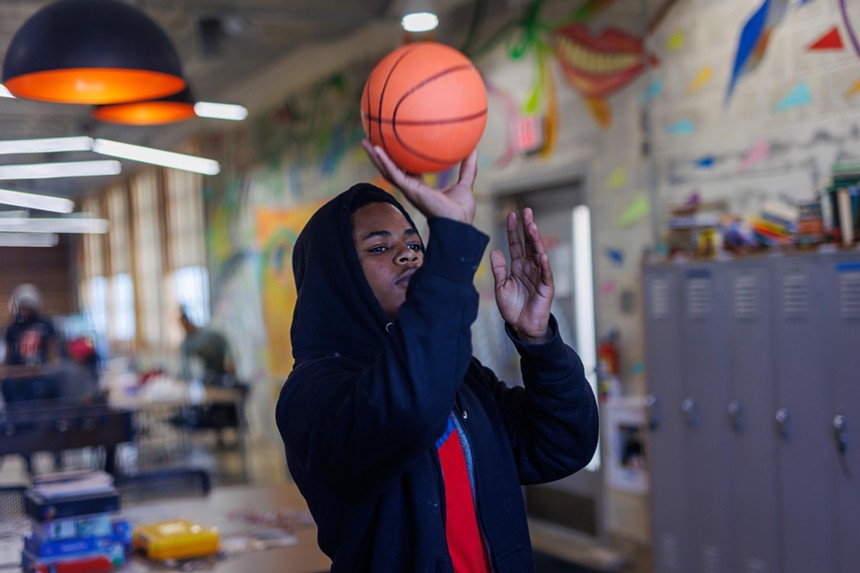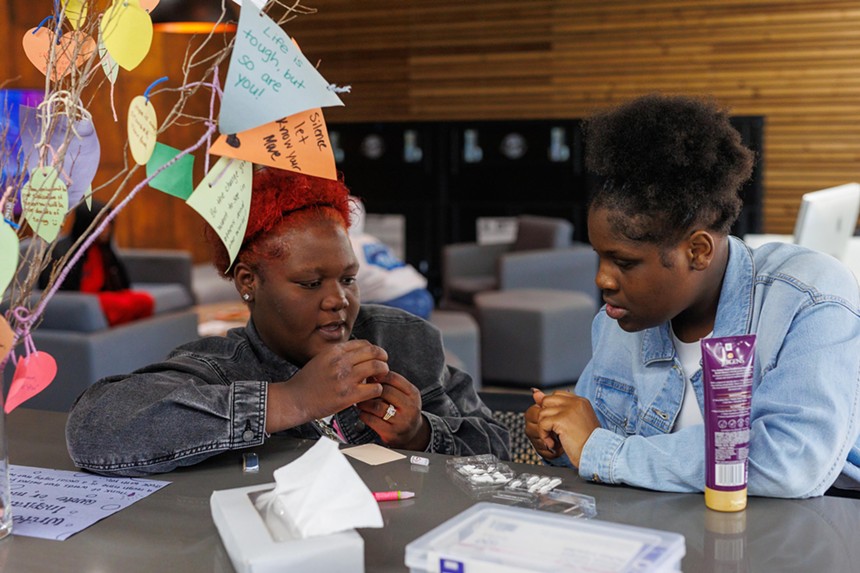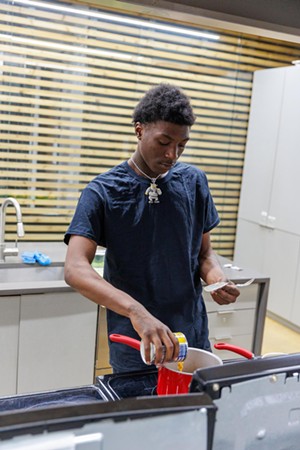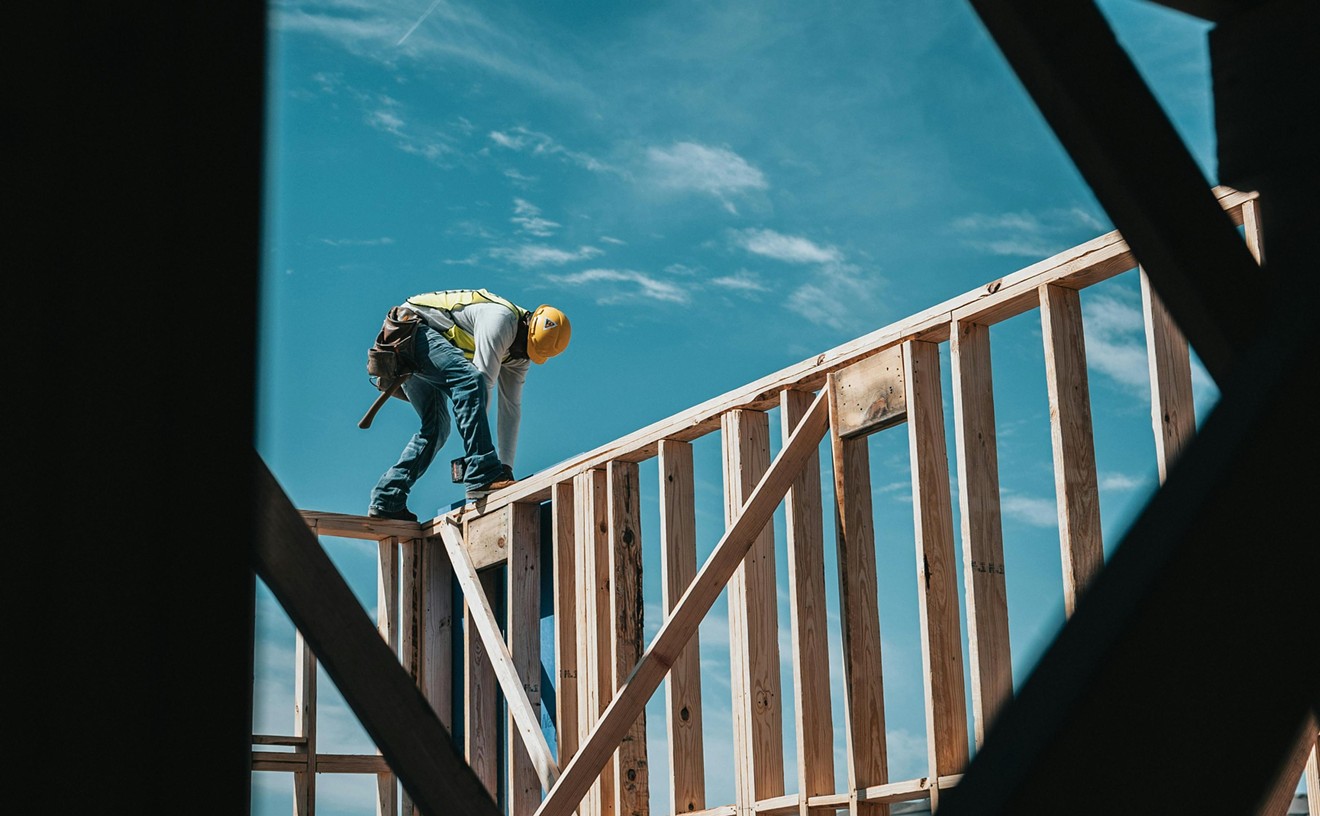“Everything here is what you need, clothes, shoes, everything,” he said. “These people are really here to listen and help. Every day, they come in here with the same attitude, ready to help.”
The homeless center for people between the ages of 14 and 21 that Salathain has come to appreciate is run by an organization called After8toEducate. Dunn first learned about After8toEducate online after looking for homeless programs. Asked what keeps bringing him back, he said, “The joy. The happiness. The love.”
After8toEducate has helped him get medication he needs and connected him with schooling. “It might take a little time, but they do help,” he said. Asked where he stays when he’s not at the drop-in center, all Dunn would say is that he moves around a lot.
Some days the youth center is packed, with up to 20 young people, Rebecah Silva, a youth outreach specialist with After8toEducate, said. The center assists young people from Dallas and from other North Texas cities such as Garland, Fort Worth and Rowlett. Some drop by for a quick visit throughout the day, and others stay for hours. Then, there are days when only one or two kids show up. Some come just to charge their phone, while others might show up for clothes or a bite to eat.
Clients might be trying to get their ID and Social Security card so they can find jobs. The center also sees many young, expecting mothers and does what it can to connect them to housing and other resources. Clients have access to Wi-Fi, showers and laundry facilities.
“So, it’s just like coaching them and talking them through the processes of those, and it’s up to them to meet us halfway,” Silva said. “I think the tough part right now is they’re teens. So, like I said on meeting us halfway, we can set up those resources. We can help them set up those appointments. But they have to get to those appointments. Sometimes it’s just trial and error.”
“Everything here is what you need, clothes, shoes, everything.” – Salathain Dunn, a homeless 20-year-old
tweet this
Many young people who could otherwise be served by her organization like to band together and find places like abandoned buildings or underpasses to stay when they have nowhere else to go. “They stay away from the adults,” she said. “That makes sense because they need their own space.”
The Fannie C. Harris Youth Center can be that space.
In this case, the age of a “youth” extends beyond the teenage years. Once they turn 21, participants have one more year to receive services from After8toEducate. The center relies on donations from the community for items like food, clothing and toiletries. “If anybody’s willing to help us out, we’re always accepting donations,” she said. “Kids can eat so they run through stuff pretty fast.”
The center has 35 shelter beds run by another organization called Jonathan’s Place, which is licensed to serve newborns to 17-year-olds. Only students enrolled in the Dallas Independent School District can go through the intake process at Jonathan’s Place to get a spot at the shelter. Some youths who aren’t homeless also use the drop-in center because they need the resources it provides.
Many people After8toEducate serves are LGBTQIA+ youths who were kicked out of their homes after coming out to their parents or legal guardians. Others might be fleeing abusive households, getting out of jail or aging out of foster care with nowhere else to go. “A lot of them are running away from abusive homes and are just tired of being abused, so they end up at After8 at the drop-in site,” Ara Grimaldo Saintus, the organization’s executive director, said.
Salathain is just one of many that After8toEducate serves. And he’s one of many homeless youths in Dallas and across the country.
Sarah Kahn, president and CEO of Housing Forward, the lead agency for the local homeless response system, said the All Neighbors Coalition, a group of organizations working to tackle local homelessness, tracks unaccompanied youths from infancy to age 24 who are homeless and not part of a family household or in institutional care. The coalition also keeps track of hotspots where youth homelessness is most rampant.
In 2023, 193 unaccompanied youths were counted during the annual census of the homeless in Dallas and Collin counties. Of those, 26 were under 18. Many more were counted in this age group, but they are in families. This group is notoriously challenging to count in Dallas and Collin counties and across the country because youth homelessness has a hidden nature to it, Kahn said.
Limited access to appropriate crisis care, emergency shelter and rehousing assistance make dealing with youth homelessness more challenging, Kahn said. There’s also a need for better access to living-wage jobs, transportation and behavioral healthcare services.
According to Kahn there’s a lack of culturally appropriate services tailored to meet the needs of this group, one that some national research says is up to 40% LGBTQIA. Pregnant and parenting teens also struggle with homelessness.
There are unique challenges that homeless youths face. Many shelters won’t accept them because they’re still minors. Since they’re younger, they may also lack identification and personal records required to get the help they need.
“It’s just really hard to navigate that space,” Saintus said. “When they’re 18, they’re technically adults, but when we see them they’re still kids. They’re still youths. A lot of them have a lot of trauma, so going to an adult shelter seems scary.”
Youth homelessness is sometimes referred to as an invisible crisis, but Saintus said it’s happening in our backyards every day.
“In our community we really don’t know that we have homeless youth,” she said. “That’s what we keep hearing. Even the kids, they go unnoticed. Even if they’re homeless in high school, they’re not going to share that they’re homeless because there's a stigma that comes around with that. So, they’re not looking for help or a lot of times people don’t even recognize they’re homeless or they’re unhoused simply because they blend very well.”
While she couldn’t be too specific for privacy reasons, Saintus shared a few success stories that have emerged from After8toEducate. One of the first people to use the drop-in center was able to get his ID, enroll in a training program, get a job and eventually move back to his home state of Michigan.
Stories of cross-country family reunification have also come out of After8toEducate. Two sisters wound up downtown at the Greyhound bus station when their mother found out about After8toEducate. She contacted the organization to help her daughters, and it was able to use some of its funds to send the sisters back to their mother in Oregon.
After8toEducate also helped a homeless youth return to her paternal grandparents in Houston. The organization still keeps up with her today. Now, she’s planning to get her high school diploma and aspires to become a beautician. Another 19-year-old spent nights at a local shelter and went to the drop-in center during the day. Now, she has a home and a job at Wingstop. She’s also attending barber school and hopes to one day open her own barbershop.
Another youth was found sleeping in the woods by police who brought her to After8toEducate. She was a runaway who hadn’t been to school since the sixth grade. Now that she’s 17, Child Protective Services couldn’t help. “She was tired of living in the woods, so she was able to come here, take a shower, get a warm meal, get clothes, et cetera,” Saintus said. She was able to get into a transitional living program after working with an After8toEducate caseworker.
Saintus estimates that some 80% of the youths they serve have trauma from becoming homeless. That’s partly why the organization has a licensed master social worker who can help homeless youths with mental health issues. “We really look at it as a holistic approach,” Saintus said.
Denise Carmona, project manager at After8toEducate, said people are often amazed by the number of homeless youths. She guesses there are far more out there than we know. “Times that by two or three, and that’s probably the accurate amount of youth homeless in Dallas,” she said. “That sounds a little more around the ballpark. That’s scary, but I believe it more and more every day because I keep seeing more new faces coming through these doors, and they’re coming from somewhere.”
She said if homeless youths had the resources they needed, they wouldn’t need to come to the drop-in center. “That means they’re needing something, and that’s why we’re here,” she said.
Another organization called Elevate North Texas is focused on providing emergency housing to young people ages 18–24 through various programs. Jason Vallejo, the organization's founder and executive director, said one program provides a 30-day hotel stay for homeless youths. During that stay, they’re provided with case management to connect them with resources they need. “We want to find out what piece of the Jenga puzzle fell out that caused everything to come tumbling down,” Vallejo said. “We know that housing is just the first part, and so we need to figure out what additional resources do they need to get back on their feet.”
The organization does what it can to connect youths to other housing options through case management.
Elevate North Texas also has a reunification program with the goal of reuniting homeless youths with family members or friends who can help provide housing. Vallejo’s outfit tries to prevent youth homelessness altogether through diversion. For example, if a youth falls behind on rent and faces eviction, Elevate North Texas will step in and try to mediate with the landlord to buy the youth more time to get caught up on rent.
Elevate North Texas sees two groups the most: those aging out of foster care and those from the LGBTQIA+ community.
“Three hundred youths age out here in North Texas every year, and at least half of those youths will end up incarcerated or experience homelessness within the first year of aging out of foster care,” Vallejo said. “That’s very staggering.”
Additionally, Vallejo said over 70% of the people Elevate North Texas works with come from LGBTQIA+ community. “It’s just heartbreaking to know that that’s what we’re seeing,” he said. The organization also helps people coming from families who have recently lost their homes. “The families are saying ‘It’s everyone for themselves,’” Vallejo noted.
One young man went to Elevate North Texas after his father was injured, leading him to lose his job and resulting in the family losing their home. They stayed in their car for a while but eventually had a wreck and had nowhere else to go. Both parents got into their own respective shelters. The younger sibling went into CPS, and the youth in question eventually found Elevate North Texas.
“We’ve had youth literally dropped off at our doorstep here." – Denise Carmona, After8toEducate
tweet this
A big barrier for youths facing homelessness is the fact that there’s no central access point for them to obtain resources, Vallejo said. “Our systems are failing our youth,” he said. “It’s just really heartbreaking.”
But help is on the way for those groups aiming to help homeless youth.
All Neighbors Coalition is rebuilding a youth homeless rehousing system with shared community-wide goals, including ensuring that no young person will experience unsheltered homelessness, avoiding shelter whenever possible with effective diversion and family reunification and providing immediate access to emergency shelter for all youth in need.
The All Neighbors Coalition was recently awarded a $9.3 million Youth Homelessness Demonstration Program grant from the U.S. Department of Housing and Urban Development to fuel this transformation over the next two years, Kahn said.
Until then Salathain and others will have to rely on organizations like Elevate North Texas and After8toEducate’s homeless youth center.
“We’ve had youth literally dropped off at our doorstep here,” Carmona of the drop-in center said. “It’s scary. It’s sad. It’s one of those things that you have to really take a step back to breathe and then jump back in because if we’re not here who else is here?”
The Fannie C. Harris Youth Center is at 4212 E. Grand Ave.















